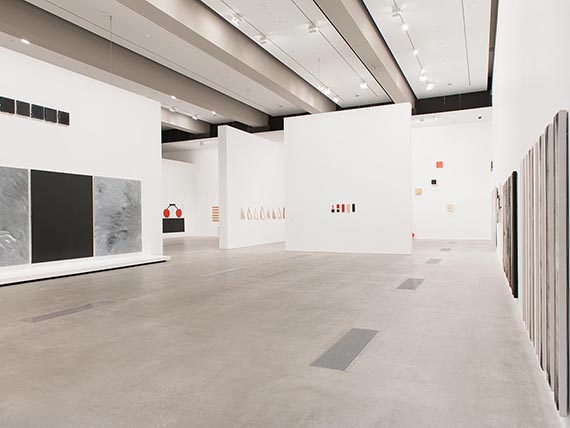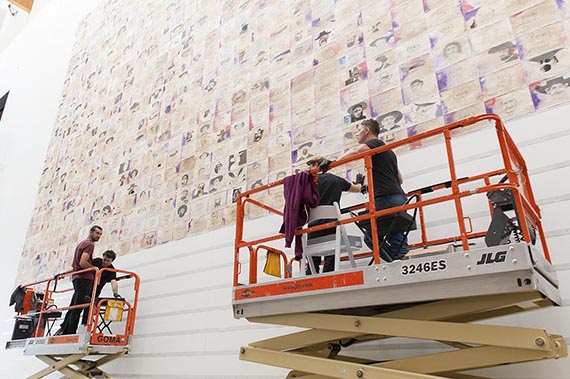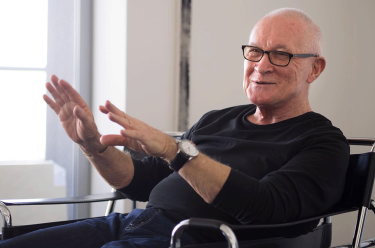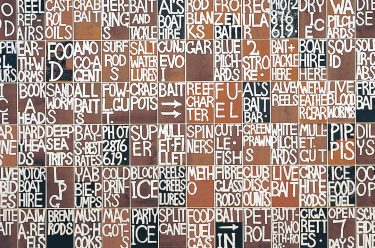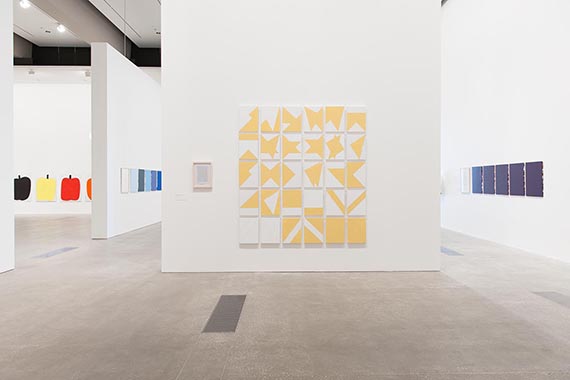
The Gallery presents a long-awaited major exhibition by Robert MacPherson, one of Australia’s most respected and senior artists. MacPherson has a 40-year exhibition history, including several Sydney Biennales and many international exhibitions. Guest curated by Ingrid Periz — a former Harkness Fellow and a graduate of the Whitney Museum Independent Study Program and New York University — ‘Robert MacPherson: The Painter’s Reach’ at the Gallery of Modern Art (GOMA) until 18 October 2015 includes works from the broad scope of four decades of the artist’s practice.
Robert MacPherson has long examined the role of the artist in the art-making process, through both modernist and conceptual forms, and his practice combines wide-ranging contemplations on the act of painting with a reverence for the local and the everyday. ‘The Painter’s Reach’ looks at how these relate within his practice. The Gallery has significant holdings of works by MacPherson, and the recent acquisition of 1000 FROG POEMS: 1000 BOSS DROVERS (“YELLOW LEAF FALLING”) FOR H.S. 1996–2014 has greatly enhanced the Collection.
The exhibition begins with MacPherson’s 1970s works, in which he explores painting as process using sets of rules and limits with gestures and marks to the scale of his own body. While resembling high-modernist painting, the artist’s early works are better described as conceptual and process-based. The text accompanying MacPherson’s 1975 exhibition at the IMA read as follows:
An awareness of modern art history, a belief that all good art comes from previous art, my rules are formed within this context.
An awareness of the means. I have no wish to subvert the means, the rectangle or negate the object.
Juxtapositioning of means (surface, handling and ground) is content.
My work makes no assumption beyond itself — then you have response, and that’s another story.
An awareness of formal principles remains. Things happen in process and are left; I am surprised.1
This use of a polemical typewritten page became of primary importance to MacPherson’s practice, but here it sets out a manifesto-like position, explaining his motivations. The act of shaping the canvas to his own body size and conventions was of key significance within this series of MacPherson’s work and the corporeal relationship of the artist to the work, and the corresponding physical relationship to the viewer continue to be important throughout his practice.
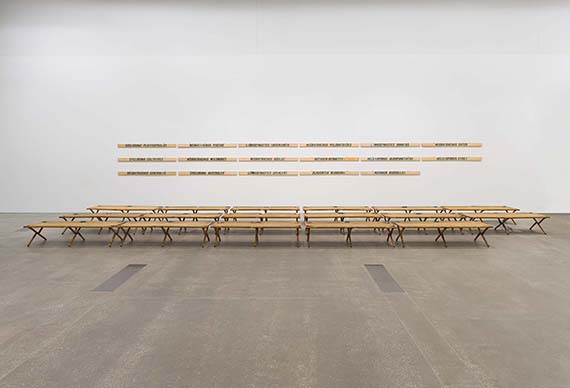
. . . about 1973 I hit on the idea that I was confronted by the container all the time in the canvas rectangle, this rectangle was shape and container and all I needed to do was to cover this rectangle container in some manner or another.2
By 1982, MacPherson had moved to the point of musing on the ubiquity of painted surfaces throughout everyday life. Bending to polish his shoes with a brush, he realised “My Shoes Are Paintings!!!” This epiphany resulted in MacPherson’s ongoing ‘Frog Poems’ series, structured around naming and categorisation. Often taking the form of an object — perhaps a chainsaw, shovel or beehive — paired with a Latin species name, the ‘Frog Poems’ use a feature of the object somehow implicated by the name. For example, the 17 canvas stretcher beds of the Gallery’s “17 FROG POEMS (FOR G. N. & A. W. (WHO BY EXAMPLE) TAUGHT THE KINDER WAY)” 1987–1989 are paired with the names of 17 burrowing or hibernating or ‘summer sleeping’ frogs.
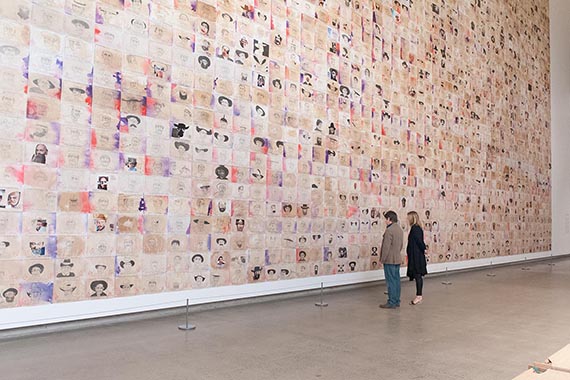
Soon after showing the first ‘Frog Poems’, MacPherson showed some drawings (also called ‘Frog Poems’) created by his alter ego, Robert Pene — a grade 4 student at Saint Joseph’s Convent, Nambour, in 1947 — which later enabled his magnificent work 1000 FROG POEMS: 1000 BOSS DROVERS (“YELLOW LEAF FALLING”) FOR H.S. 1996–2014. Completed over two decades, it takes up the large wall of the Long Gallery. This work also forms the core of the commissioned interactive project for the Children’s Art Centre, ‘Swags and Swamp Rats’, where children can go on a journey through the exhibition, learning about the people, places and objects that inspire the artist.
Through many serial works, MacPherson’s practice has evolved idiosyncratically, from painting to object-based ‘Frog Poems’ musing on denotative meanings, to poetic painted texts such as the ‘Mayfair’ series, investigating the formal and connotative qualities of language. MacPherson’s text piece ‘I ALWAYS BUY MY LUNCH AT THE MAYFAIR BAR’ underpins his roadside signage works, which could be seen as landscape paintings in situ. Instead of trying to capture something of the Australian landscape into one image, they are sited ‘in’ the landscape, often offering local produce or activities local to their situation and season — Bethonga Gold pineapples, Lebanese cucumbers, kebabs, fishing gear — employing evocative slang and vernacular language. These works introduce a lightness and playfulness; playing with language and meaning while still exploring painterly concerns such as colour relationships, formal interactions and surface ‘incident’. MacPherson often returns to concerns and subjects identified earlier in his works. His most recent series, “MAYFAIR BAR REVISITED”, returns to the Mayfair Bar text in series of colorful monochromes and abstract paintings relating to the various routines, rituals and productions of the sandwich shop.
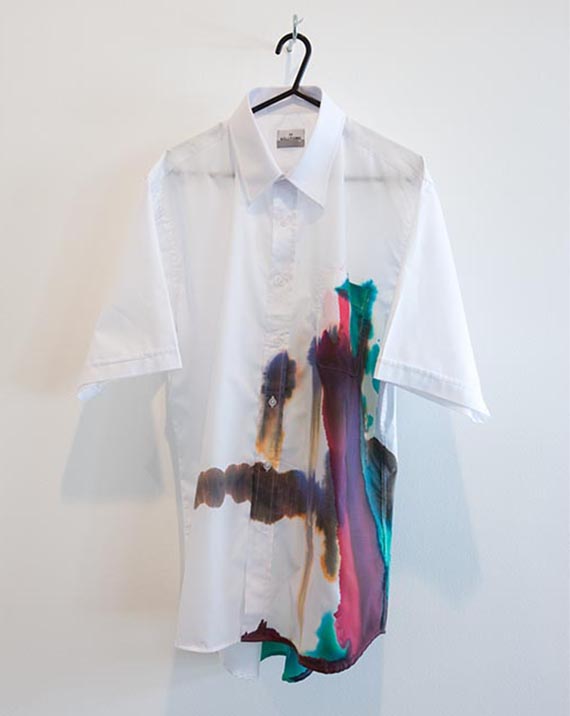
Similarly, MacPherson’s ‘PEERLESS’ series returns to the scale of his own body. Peerless Dry Cleaners is MacPherson’s local drycleaner in Brisbane. The artist’s shirt widths determined the size of the canvas stretchers, and MacPherson takes the drycleaner’s list of colours on his receipt to determine the colour of the canvas. As Ingrid Periz notes:
If the 70s paintings can be understood as process-oriented — how the paint fell from the brush — these works can be understood as procedurally driven, with MacPherson using the cleaner’s procedure for handling laundry as the means of generating work while distancing, if not removing, the role of artistic choice.3
IN “MAYFAIR: (PEERLESS) 3RD GROUP 4 S.F.” 2002–2007, MacPherson acknowledges Brisbane colorist Sam Fullbrook in his dedication, and hangs a group of short-sleeved men’s shirts with a weeping breast pocket, the swathes of colour fall as if created by a leaking pen.
Discussed and exhibited in a multitude of artistic contexts, Robert MacPherson continues to inspire and influence successive generations of Australian artists with his highly intelligent and rigorous yet expansive and inclusive practice, which invites us all contemplate the processes by which art is made, and the ways we create meaning.
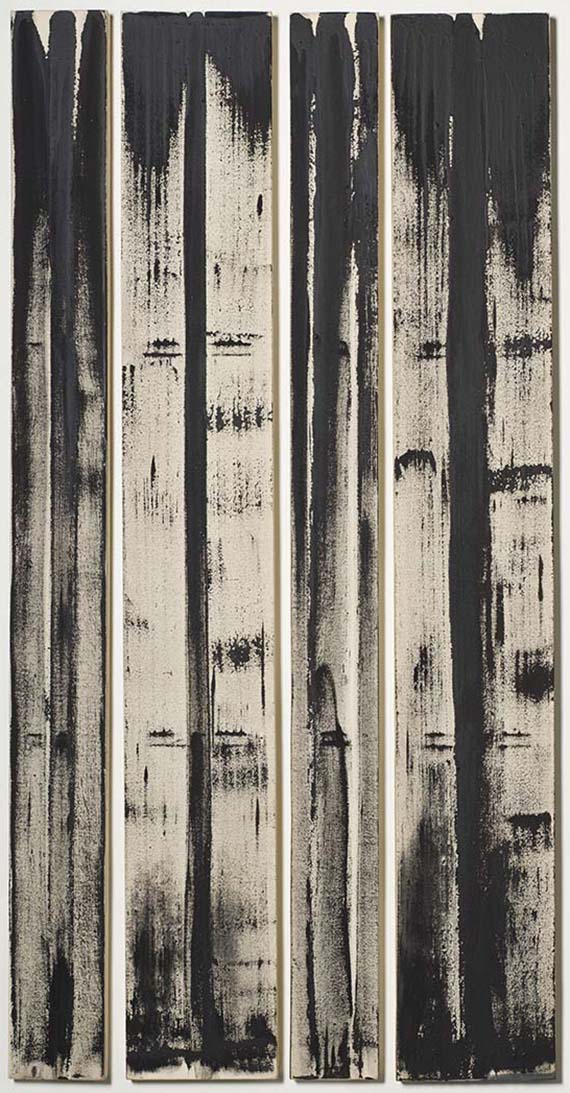
Angela Goddard is former Curator, Australian Art to 1975, QAGOMA
Endnotes
1 Robert MacPherson, artist’s statement from Bulletin, Institute of Modern Art, Brisbane, vol.1, no.1, 1975, unpaginated.
2 Robert MacPherson, A Proposition to Draw [exhibition catalogue], University of Queensland Art Museum, Brisbane, 1993, unpaginated.
3 Ingrid Periz, ‘The painter’s reach’, in Robert MacPherson: The Painter’s Reach, Queensland Art Gallery | Gallery of Modern Art, Brisbane, 2015, pp.15–49.
Know Brisbane through the QAGOMA Collection / Delve into our Queensland Stories / Read more about Australian Art / Subscribe to QAGOMA YouTube to go behind-the-scenes
‘The Painter’s Reach‘ at the Gallery of Modern Art (GOMA) explored the work of Robert MacPherson and included paintings, installations, ephemera and works on paper, showing how the artist’s reach begins with the particular and extends far beyond.
#RobertMacPherson #QAGOMA
